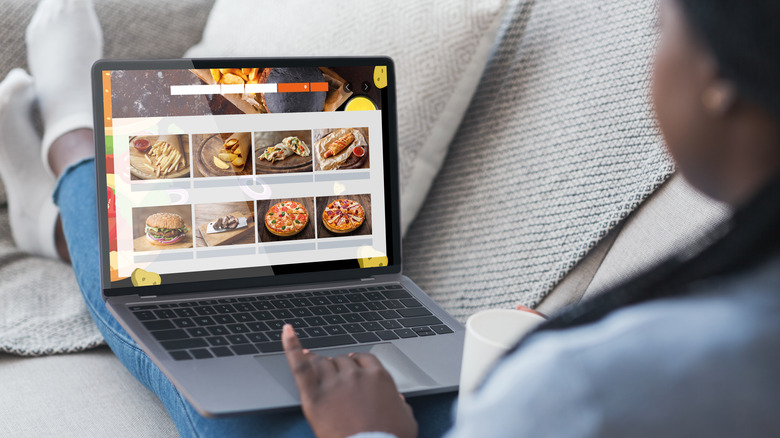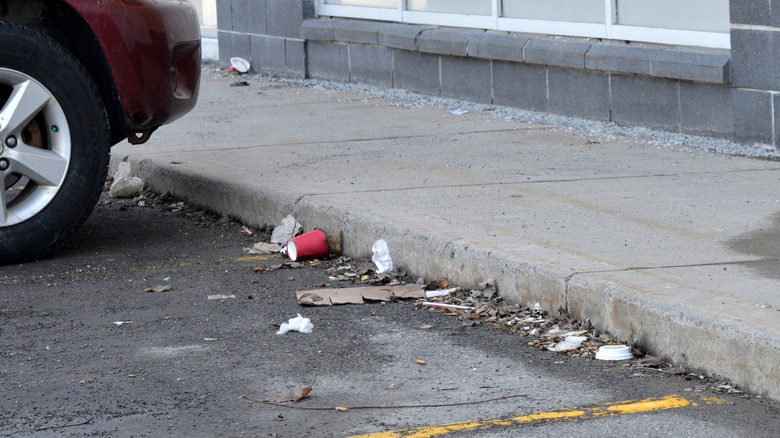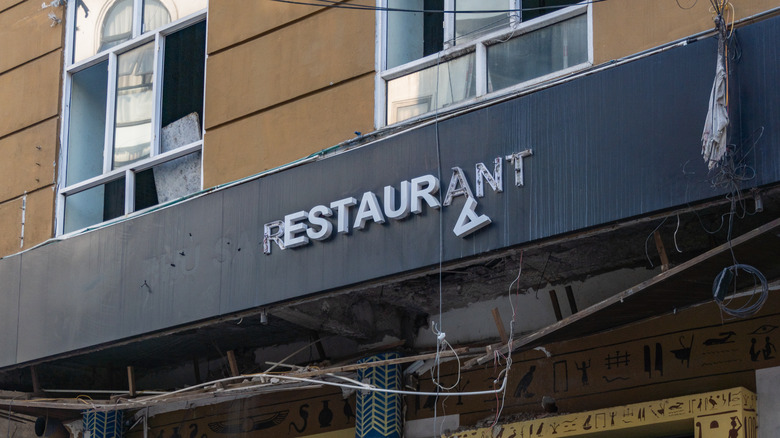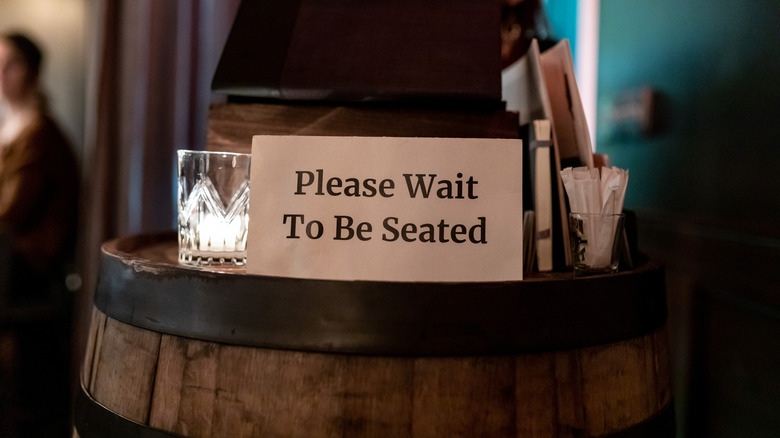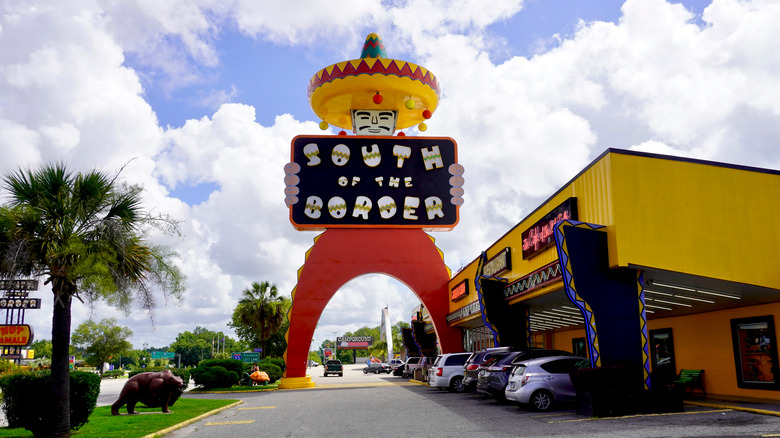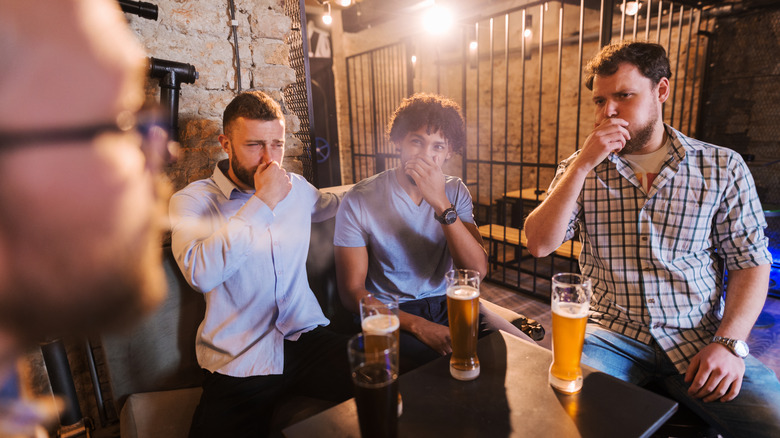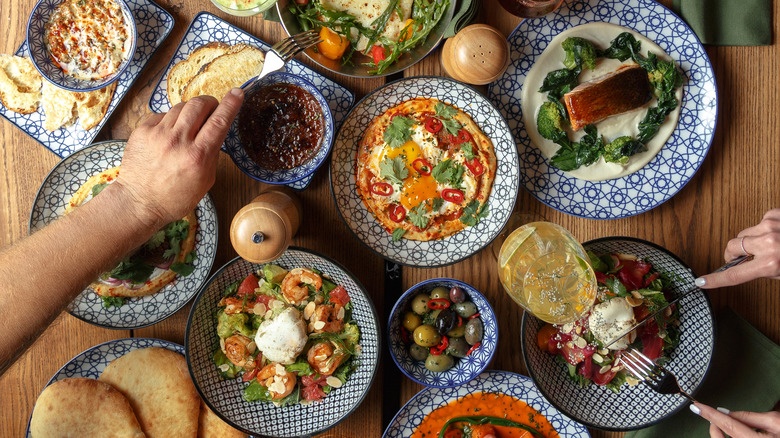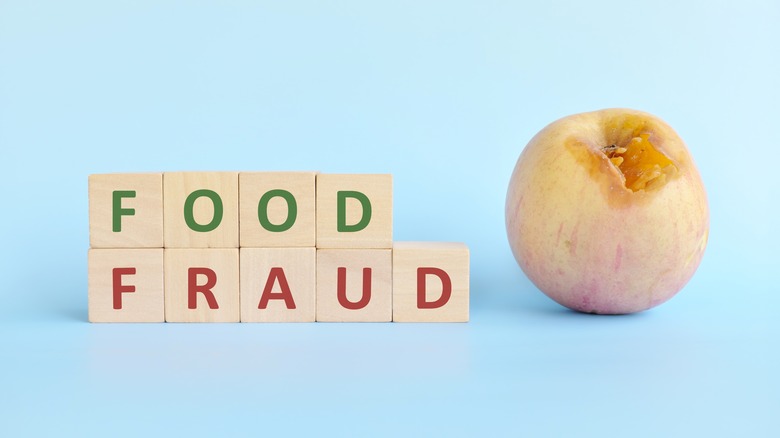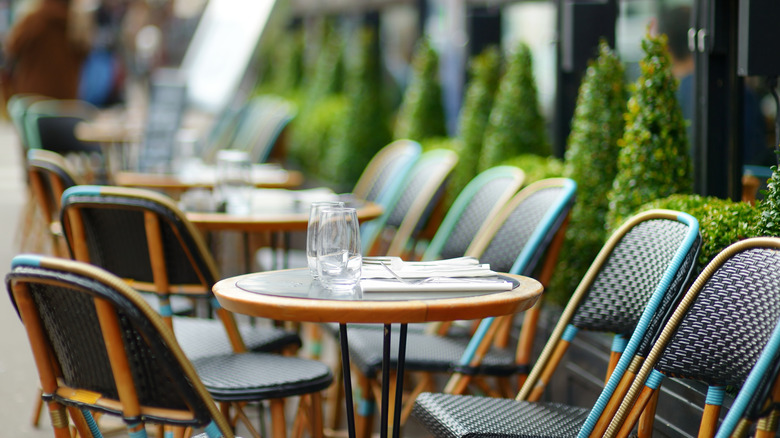14 Red Flags That Indicate A Bad Restaurant
"Running a restaurant is easy," said nobody, ever. We restauranteurs can tell you that it takes truckloads of patience, countless hours of sleepless nights, headaches, heartaches, plenty of manic energy, and, did I mention patience? If it were easy, there wouldn't be so many red flags to indicate a bad restaurant. There can be a trail of red flags, starting from an online search across continents to the restaurant's parking lot and on through the dining room, behind the kitchen line, and into the bathrooms.
There are many reasons restaurants fail, which might not necessarily be evident to the patron — like ignoring food costs, sloppy accounting, or substandard technology software. To be fair, running a restaurant in today's economically challenged, Covid-19 riddled, and employment deficient climate has made things extremely challenging for restaurant owners. We get that. Diners should show patience and empathy and keep these challenges in mind. But, we're going to look at 14 red flags that can be avoided by restaurateurs, and should be avoided by their patrons.
Bad or ignored reviews
When reading reviews online, there are many things to be aware of. For instance, a lousy review might be put out by a competitor, a disgruntled employee, or someone who left a review for the wrong restaurant with a similar name. Often passions can fuel a review, like a third party who "heard bad things" or an activist who heard a bakery would not bake a cake for a same-gender wedding. So, reading enough reviews is important to attain an overall sense of the place.
Too many bad reviews certainly raise a red flag, and so should a restaurant's lack of response. Restaurants are not perfect — all make mistakes — but it can be very telling when a restaurateur doesn't take the time to publicly address a problem. The lack of response might give the sense that the restaurant doesn't care or, at the very least, is not paying attention. Either scenario is red flag fodder. It's best practice that restaurant owners should read their reviews and respond to each review, both good and bad. Responding to reviews can not only help a situation, but it can also strengthen customer relationships by showing their concern and determination to make things right. If reviewers hear crickets, move on in your search.
A less than stellar website
It's a bit perplexing why restaurants are notorious for having poorly designed websites. Some of the worst restaurant website practices range from poor navigation and lack of fresh content to websites that are simply unpleasant looking. A well-designed and great-looking website can improve a restaurant's business. Touch Bistro, which maintains POS management systems in close to 30,000 restaurants worldwide, reports that 77% of diners say that they visit a restaurant's website before eating the food, and 70% of that group report avoiding a restaurant because of a bad website.
So, how can a restaurant's website improve its business? You can look for fun stuff like loyalty programs, merchandise, gift cards, and social media links, or stick to the website basics. FSR Magazine simply narrows things down with a list of the five essentials of a good restaurant website, which include professional photography, up-to-date information (ranging form the menu to a restaurant's contact information), mobile optimization, and "online curb appeal." Websites that are a turn-off can send up red flags that the restaurant may not care — and maybe the lack of quality only begins at your computer screen.
Dirty and unloved parking lot
Leaving the restaurant's website, we hungrily grab our car keys and head out for a satisfying meal. But, the adage, "you only get one chance to make a good first impression," might not apply here. Parking lots aren't just a place to park your car. They can be a window into what goes on behind the restaurant's door. One can argue that a parking lot or streetside entrance littered with trash and debris can suggest laziness and poor management. Just like questioning the livability of an apartment building with overflowing and smelly dumpsters out front, an unkept restaurant parking lot can, and probably should, scare people away.
The opposite can be said of a clean, well-maintained parking lot or attractive restaurant street corridor, which can have many positive benefits, including deterring (and, more importantly, not attracting) rodents, discouraging litterbugs, and preventing litigious situations that can come from eroded concrete and large cracks. Ironically, that large concrete slab should give you a warm, fuzzy feeling. If the front of a restaurant doesn't convey cleanliness and attention to detail, it's a red flag. Put your hand back on the shifter and drive on.
Bad restaurant signage
Should a restaurant's signage go into the same category as the parking lot when discussing first impressions? You bet it should. But, a restaurant's signage is a significant enough component to warrant its own mention. Not only can effective restaurant signage make a business stand out from its competitors, but it can also make the difference between whether someone will walk through the front door — or walk on. Euro Logo insists that every business owner needs to be aware of the importance of their signage: Statistically, 16% of consumers learn about a business from advertising, 33% rely on word-of-mouth, and a whopping 46% learn of a business from seeing its sign.
Euro Logo also says 80% of those polled will walk through the door because they were either impressed or intrigued by a restaurant's sign out front, and 70% of them believe that the quality of sign is in direct correlation to the products and services of the business it represents. Much like any restaurant red flag, the common denominator has to do with caring for the business and customers. A sign should signal both pride and trust. Signage that is dirty, uncared for, or broken might be lighting the way to a dirty, uncared for, or broken business.
A not-so-warm welcome
There's an old saying in the hospitality industry: "You are only as good as your worst employee." Hosts are the restaurant's first human contact (and the decision-maker for whether you secure prime restaurant seating or stand in the cold). Their duties are very specific but being rude or uncaring is not on that list. Many attitude-based requirements can get lost in the shuffle, and that's where a red flag is unfurled. So, why do some restaurants insist on putting their worst employee out front?
Global restaurant consultants list poor greeters at the top of the most common restaurant server mistakes. A host that lacks menu knowledge, has a poor attitude, or seems disinterested or detached, may result from a disgruntled worker or one who lacks training. At the very least, this is an annoyance and an excellent reason to go elsewhere; but can it also mean that the kitchen staff is disgruntled or lacks training? Yep. Best to move on and get treated better someplace else.
Dirty menus
Prior to the pandemic, there was no excuse for filthy menus with greasy fingerprints. Post-pandemic, there are really no excuses. Now, more than ever, restaurants should be showing how clean the establishment can be. When examining how dirty restaurant menus really are, we learn that an average menu offers specials that can include 185,000 bacteria, which is about 100 times more bacteria that you'd find on a toilet seat. Is it better to use the ever-popular QR code to get your menu online? You bet it is. QR codes for menus are one of the good things that have come out of the pandemic, along with curb-side delivery and more outdoor dining options.
But, many restaurants have yet to embrace the QR code craze. For that matter, many patrons find the codes clunky, confusing, and are hard to navigate. Although the landscape is changing, hand-held restaurant menus are sticking around, at least for the near future. Menus that look clean can still carry plenty of bacteria, so if your menu is stained and looks disgusting, that goes into the same category as a restaurant not caring. Think of a dirty menu as a red flag that is literally placed into your hands with a "I'll be delivering you bacteria today."
Staff turnover and attitude
Sometimes you just have to look at the servers for a restaurant's red flag. Reading body language is an essential tool, and watching your server roll their eyes or your bartenders commiserating in the corner might be a sure sign that these folks are not happy. The question is, why not? MHR Global lists high employee turnover rates, poor communication between employees, and high absence rates as the top three indicators that a company's culture is turning toxic.
A bigger question is why are they unhappy, or why can't this restaurant keep a regular staff? The answers can vary and might not have to do with the restaurant (pandemic staffing issues come to mind). But, if staff turnover is that obvious, or a large majority of staff seems unhappy, it might be that they're not being treated well. Poor management can lead to an unhealthy climate, which will trickle onto the customer. There are ways to keep servers happy. Improved training, giving servers a voice can let them feel a part of the team, and letting servers taste the food can improve confidence and morale. Rewarding sales goals or offering incentives to waitstaff are great motivators, as well.
Dining room full of tourists
What's the first rule for dining out while on vacation? Eat where the locals eat! Walking into a restaurant that looks full of tourists might be a red flag. Avoiding restaurants that blare "tourist trap" is rule number one for many vacationers. Now, to be clear, some restaurants are so famous that they will always have a large percentage of tourists. Iconic restaurants like Le Bernardin or Eleven Madison Park in New York, Noma in Copenhagen, and Steirereck in Vienna are restaurants travelers should not miss. These spots are bound to have a fair share of tourists. What we are talking about are "tourist trap restaurants" that have menus that are specifically geared toward unsuspecting travelers — there's the difference.
Now, it's true that many devout "foodies" can't help but want to visit the themed restaurants of Las Vegas, and there's nothing wrong with that. Eating at Disney World's Epcot restaurants can easily be considered kitschy by more serious pallets, but that's okay too! However, we're red-flagging the time when you think you've found the honest-to-goodness, local's favorite or some tucked-away hang-out only to end up sitting next to people who are also spending too much on mediocre food. Whoops. Get out of there and try the next best-kept secret.
Unsavory smells
Searing hamburger patties, frying clams, and steaming fajitas are mouth-watering aromas that can send your olfactory senses on a heavenly sojourn. The opposite can be said for many other odors that should not be part of your restaurant experience and may raise the reddest of flags. Some of the top restaurant stinks include fun things like rancid food, filthy restrooms, dirty mops, mold, and various clogged things like drain lines, grease traps, and air conditioning filters. Sly and the Family Stone forgot to mention how "hot fun in the summertime" brings out the worst in a kitchen dumpster.
Sometimes smells can come from things that used to smell good but hung around too long. The scent of grilling a salmon on a cedar plank can instantly turn the burger-loving Whimpy (of Popeye fame) into a full-blown pescatarian; but after a long while, that kitchen shouldn't still smell like fish. The reason some kitchen smells hang around might be because of something as simple as a stove hood's dirty fan filters. Not the end of the world, but it's another way of showing that the restaurant of your choice might not be cleaning as best as it can. The rule of thumb is a simple one: If you dislike how a restaurant smells, don't eat there.
Filthy bathrooms
If someone furnished you with a list of fast-food restaurants with the worst bathrooms, would you use it as a dining guide? Start at the restaurant with the filthiest loo and eat your way down the list, perhaps? Probably not. If the bathroom is filthy, those familiar red flags of safety and breach of trust arise, as well as the question, "If the bathroom looks like this, what does the kitchen look like?" But, mistrust and health hazards are just a part of a negatively affected bottom line. Welcome to social media.
We restaurateurs know another industry saying: "Have a great meal, and you'll tell three friends. Have a bad meal one, and you'll tell 13." These percentages are less damaging than what Clean Link reports can be roughly 75% of Americans have had a negative reception of a business based on a dirty bathroom (and two-thirds of Americans polled viewed businesses negatively if customers are left with no soap or paper towels).
Just as diners like to post photos of a delicious meal on Instagram, unhappy patrons also post pictures of disgusting bathrooms. The cost for gross restrooms to an establishment's image and bottom line is steep if diners post their potty photos on social media and travel blogs.
Too varied of a menu
Let's face it; you can't be everything to everyone. If a menu includes duck a l'orange, Italian meatballs, baba ghanouj, escargots, baby back ribs, and tacos, add a red flag to the menu (fun fact: This list is from an actual menu in Delray Beach, Florida, which gave birth to this article). Sometimes a menu that's too big or covers too many styles or regional food groups can seem (and taste) unfocused. This all-over-the-map menu style most likely sprouted from diners not being willing to drive very far. But, as tastes became more refined, restaurant guests are more open to traveling farther to meet their specific cravings, which now include scaled-down menus.
But, there are other reasons restaurants should make menus smaller. Chef Works lists other pitfalls having to do with chefs looking like "jacks of all trades, masters of none," diners getting decision fatigue, challenges to meet dietary needs, and, more frankly, a feeling of a restaurant being on the level of a "greasy spoon diner." This is fine if you happen to be in a greasy spoon eatery (the best U.S. diners should be on your bucket list), but if you're not, opt for more clarity than a ristorante-brasserie-hibachi-haus approach.
Too many off-season menu items
You may not necessarily require a seasonal produce guide to help you navigate what is fresh from what isn't on a menu, but it can sometimes help. There are many reasons for having a seasonal menu in your restaurant. Reasons range from enhanced marketing opportunities, improved staff enthusiasm, and maintaining smarter food budgets to become more profitable, according to Gourmet Kitchen. These reasons can also benefit the consumer, as do fresh flavors. Maintaining a menu with seasonal recipes keeps things tasting fresher and more current.
But, just because a summer menu features fresh parsnips does not necessarily mean that a red flag has been waved. More and more, fruits and vegetables are grown year-round in greenhouses and hothouses. Although Brussels sprouts, which typically used to be a fall feature item (and rarely, at that), are now commonplace on menus year-round, it might be worth your while to find out where your meal may have come from if freshness is a concern (and it should be). Red flags might not be as evident as summer squash on a Valentine's Day menu, but if a menu seems like a seasonal mish-mosh, it might be just that.
Misrepresented menu items
From imitation crab meat to fictional farms, "food fraud" can lurk on any menu. As the term "farm-to-table" gained in popularity, so did the misrepresentation of many menu items. Because of this unlawful practice, diners might want to ask the server where, for instance, the restaurant's meat comes from. If they can unflinchingly name the specialty distributor, farm, or ranch by name, then stick that napkin into your shirt neck, grab the steak knife, and go for it. If not, that's a red flag.
But, it doesn't stop at beef. Seafood fraud is running (or rather, swimming) rampant. Oceana reports that seafood is mislabeled 25% to 70% of the time, so the red snapper on the menu might be a less expensive variety or more readily available fish to improve food costs.
The U.S. Food & Drug Administration uses a more fancier term for food fraud, calling out the "economically motivated adulteration" of an ingredient or part of food or the absence or substitution of a food. It's any time a food is misrepresented in order to appear to be of greater value than it is. If you have questions about something on the menu, and your economically motivated adulteration radar goes up, simply call your server over, slap your Food Fraud Prevention Textbook on the table, look them in the eye, and ask, "Is the salmon really from Alaska?"
Empty restaurants
This red flag comes with an asterisk because it might be as double-sided. An empty restaurant is rarely viewed as a positive thing for diners or restauranteurs. Most humans gravitate towards busier restaurants for reasons ranging from tastier menus and cheaper coffee to cleaner dining rooms. Fast Company dives a bit deeper and reveals subconscious reasons having to do with social proof: If there's a bigger crowd, it must be a safe bet! It goes back to the powers of trust. Say what you will about McDonald's as a restaurant, but when the sign reads, "Serving Over 52 Million People," the owners know a bit about the powers of social proof.
But, there are also reasons for walking into empty restaurants. Thanks to Covid-19 and its variant cousins, a more vacant restaurant can mean a safer one. Another reason concerns cultures: A truly authentic Mexican restaurant might start its lunch rush at 1:30 p.m. or later. If you've ever gone out (as an American) to a 6:30 p.m. dinner in Paris, you might get the early, early bird menu, and the most respected Korean eateries can get jammin' around 10 p.m. Empty restaurants may send up a red flag, and for good reasons, but giving an empty restaurant a try might just pay off.


